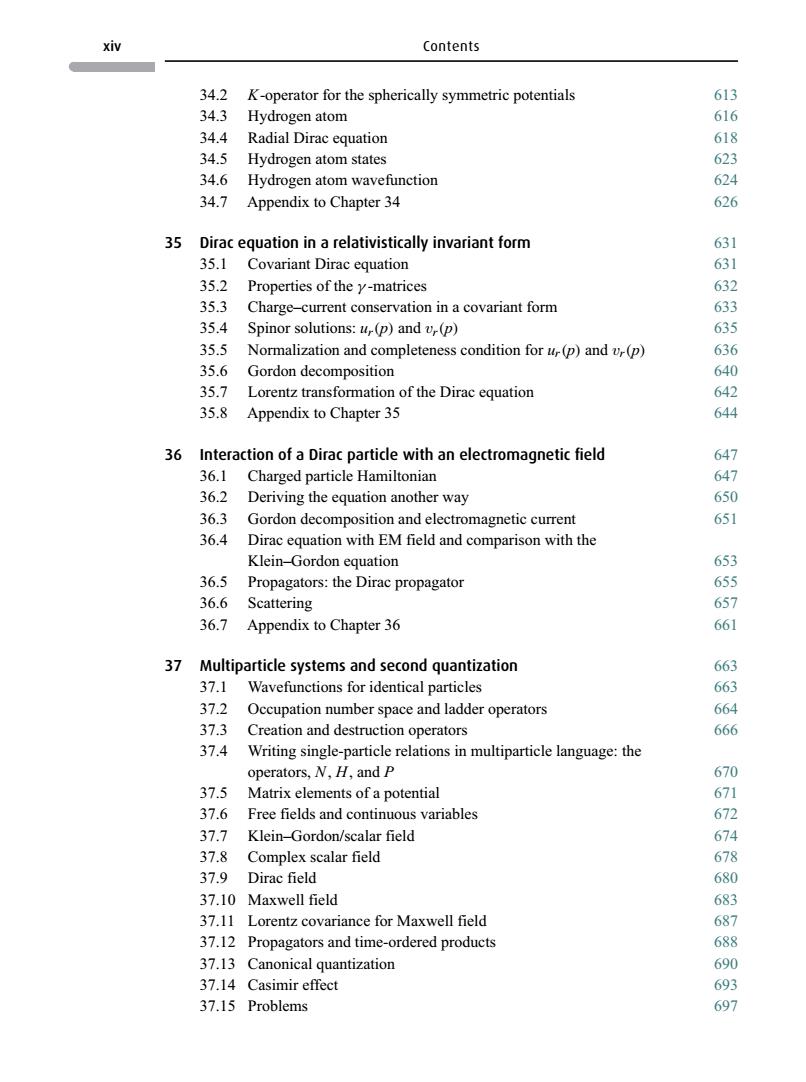正在加载图片...

XIV Contents 34.2 K-operator for the spherically symmetric potentials 613 34.3 Hydrogen atom 616 34.4 Radial Dirac equation 618 34.5 Hydrogen atom states 623 34.6 Hydrogen atom wavefunction 624 34.7 Appendix to Chapter 34 626 35 Dirac equation in a relativistically invariant form 631 35.1 Covariant Dirac equation 631 35.2 Properties of the y-matrices 632 35.3 Charge-current conservation in a covariant form 633 35.4 Spinor solutions:ur(p)and v(p) 635 35.5 Normalization and completeness condition for ur(p)and vr(p) 636 35.6 Gordon decomposition 640 35.7 Lorentz transformation of the Dirac equation 642 35.8 Appendix to Chapter 35 644 36 Interaction of a Dirac particle with an electromagnetic field 647 36.1 Charged particle Hamiltonian 647 36.2 Deriving the equation another way 650 36.3 Gordon decomposition and electromagnetic current 651 36.4 Dirac equation with EM field and comparison with the Klein-Gordon equation 653 36.5 Propagators:the Dirac propagator 655 36.6 Scattering 657 36.7 Appendix to Chapter 36 661 37 Multiparticle systems and second quantization 663 37.1 Wavefunctions for identical particles 663 37.2 Occupation number space and ladder operators 664 37.3 Creation and destruction operators 666 37.4 Writing single-particle relations in multiparticle language:the operators,N,H,and P 670 37.5 Matrix elements of a potential 671 37.6 Free fields and continuous variables 672 37.7 Klein-Gordon/scalar field 674 37.8 Complex scalar field 678 37.9 Dirac field 680 37.10 Maxwell field 683 37.11 Lorentz covariance for Maxwell field 687 37.12 Propagators and time-ordered products 688 37.13 Canonical quantization 690 37.14 Casimir effect 693 37.15 Problems 697xiv Contents 34.2 K-operator for the spherically symmetric potentials 613 34.3 Hydrogen atom 616 34.4 Radial Dirac equation 618 34.5 Hydrogen atom states 623 34.6 Hydrogen atom wavefunction 624 34.7 Appendix to Chapter 34 626 35 Dirac equation in a relativistically invariant form 631 35.1 Covariant Dirac equation 631 35.2 Properties of the γ -matrices 632 35.3 Charge–current conservation in a covariant form 633 35.4 Spinor solutions: ur(p) and vr(p) 635 35.5 Normalization and completeness condition for ur(p) and vr(p) 636 35.6 Gordon decomposition 640 35.7 Lorentz transformation of the Dirac equation 642 35.8 Appendix to Chapter 35 644 36 Interaction of a Dirac particle with an electromagnetic field 647 36.1 Charged particle Hamiltonian 647 36.2 Deriving the equation another way 650 36.3 Gordon decomposition and electromagnetic current 651 36.4 Dirac equation with EM field and comparison with the Klein–Gordon equation 653 36.5 Propagators: the Dirac propagator 655 36.6 Scattering 657 36.7 Appendix to Chapter 36 661 37 Multiparticle systems and second quantization 663 37.1 Wavefunctions for identical particles 663 37.2 Occupation number space and ladder operators 664 37.3 Creation and destruction operators 666 37.4 Writing single-particle relations in multiparticle language: the operators, N, H, and P 670 37.5 Matrix elements of a potential 671 37.6 Free fields and continuous variables 672 37.7 Klein–Gordon/scalar field 674 37.8 Complex scalar field 678 37.9 Dirac field 680 37.10 Maxwell field 683 37.11 Lorentz covariance for Maxwell field 687 37.12 Propagators and time-ordered products 688 37.13 Canonical quantization 690 37.14 Casimir effect 693 37.15 Problems 697